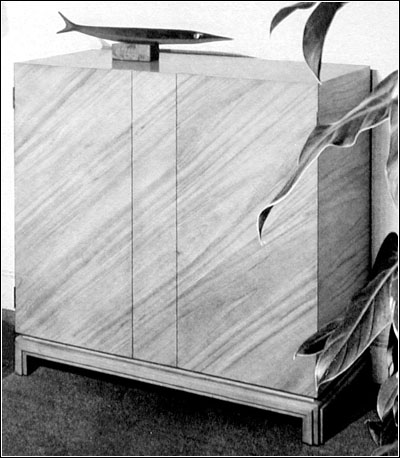Of Old Radios And Related Items--Published Monthly
RCA Berkshire Recollections
By Ray Bintliff
Web Edition
When staff member Ray Bintliff was given the task of editing Norman Braithwaite's article about the RCA Berkshire series, he was delighted and remarked, "I worked on that project." Below are Ray's recollections of RCA's entry into the custom radio/TV market. (Editor)
Working on Norman Braithwaite's article about the RCA Berkshire line caused a few old memories to bubble to the surface. The following recollections may provide some useful background for Braithwaite's account of the Berkshire project.
The RCA Service Company's Television Service branches were established to provide TV installation and repair service to consumers and dealers. However, some branches also provided technical services for VIPs and RCA/NBC executive accounts as well as other special activities. During my tenure in New York City in the late 1940s, I had the good fortune to be assigned to some of those special activities. Being the "Berkshire guy" was one of those assignments. Working with Harriet Higginson and the Berkshire project was a memorable experience even though the Berkshire never became a commercial success. It was a delight to work with Ms. Higginson. She seemed to have carte blanche and a very adequate budget.
The Contemporary model, designed by T.H. Robsjohn Gibbings, measured 44 3/8" x 40" x 21". It was priced at $1,700.Marketing efforts were "big time" -- various Berkshire models were placed on display in the lobby of the Plaza Hotel. Sets were also placed in the homes and offices of VIPs and RCA/NBC executives. The models ranged from the impressive Breakfront to the simpler contemporary-styled models. My recollection is that some sets were housed in custom cabinets as well as the standard models described in Braithwaite's article.
An important component of the Berkshire sets was RCA's LC-1 speaker designed by Dr. Harry F. Olson. This famous speaker and its successor, the LC-1A, are superb speakers. I worked on a number of projects that employed this speaker and sat through several comparative listening tests. These speakers were the gold standard. I can recall one application in which the LC-1A was part of an audio system driven by a direct audio line to the NBC studios. When the sound effects man broke a glass, your first reaction was to go looking for a broom. It was that good.
The TV set used in the Berkshire series was RCA's commercial projection TV that used a 15" x 20" screen. It was developed to compete with DuMont's large-screen CRTs which because of their convex viewing surface always reminded me of viewing a picture through the bottom of a goldfish bowl. The projection sets were not without issues. The 27 KV anode voltage was a great dust precipitator. Mirrors and lenses required periodic cleaning. The 15 kHz sweep frequency was a problem for the dogs in a household. Adjustments, both electronic and optical, were necessary to obtain vertical and horizontal linearity. Adjusting these sets was a challenge.
As to the receiver, it sounded good. Again Dr. Olson was in the picture with his version of a noise suppressor. Noise suppression was a necessity for playing 78 rpm records. RCA's ratio detector circuit, also called the Foster-Seeley circuit, was developed in the RCA Licensing Lab to avoid payments to Armstrong. It worked, but not as well as Armstrong's discriminator.
The use of the Collins Autotune mechanism made the set easy to operate, when it worked. This application of the Autotune was troublesome at best. Skilled as they were at TV repair, most technicians in the RCA Service branches were incapable of maintaining the tuners, and roving specialists were dispatched to the various service branches on an as-needed basis. And not always with happy results.
I wonder what happened to those sets placed in the homes of RCA executives and others. Did General Sarnoff have one in his home? Nope, because he had an even more impressive home entertainment system. When time permits and more memories bubble to the surface, I intend to write about the ultimate home entertainment system, ca. 1947.
A.R.C. staff member Ray Bintliff holds an Amateur Extra Class license. A retired engineer, he enjoys repairing and restoring pre-1945 radios and test equipment. His interests also include electronic equipment and audio reproduction.)
| [Free Sample] [Books, etc., For Sale] [Subscribe to A.R.C./Renew] [Classified Ads] [Auction Prices] [Event Calendar] [Links] [Home] [Issue Archives] [Book Reviews] [Subscription Information] [A.R.C. FAQ] URL = http://www.antiqueradio.com/Dec07_Bintliff_Recollections.html Copyright © 1996-2007 by John V. Terrey - For personal use only. Last revised: December 1, 2007. For Customer Assistance please contact ARC@antiqueradio.com or call (866) 371-0512 toll free
Antique Radio Classified |
